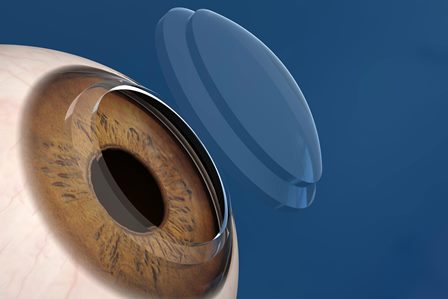Hey there, fellow eye enthusiasts! Are you or a loved one considering an endothelial corneal transplant? Well, you’ve come to the right place! In this ultimate guide, we’re going to break down everything you need to know about this fascinating procedure, from start to finish. We’ll walk you through the entire process, exploring the ins and outs of the surgery itself, the recovery period, and the incredible results you can expect. So, whether you’re a curious soul eager to learn about the world of corneal transplants or someone seeking information for a potential surgery, buckle up and get ready to dive into the wonderful world of endothelial corneal transplants!
What is an Endothelial Corneal Transplant?
An endothelial corneal transplant, commonly referred to as a Descemet’s stripping endothelial keratoplasty (DSEK) or Descemet’s membrane endothelial keratoplasty (DMEK), is a highly effective surgical procedure aimed at treating various diseases affecting the innermost layer of the cornea. The endothelial corneal transplant is specifically designed to address conditions that impair the functionality of this crucial layer, such as Fuchs’ dystrophy or bullous keratopathy. By replacing the damaged endothelial cells, which are responsible for maintaining the cornea’s clarity and health, this procedure aims to restore vision and alleviate symptoms associated with these conditions. With its innovative techniques and advancements in eye surgery, the endothelial corneal transplant has become a reliable and promising option for patients seeking to regain their visual acuity and improve their quality of life.
Endothelial corneal transplant, also known as Descemet’s stripping automated endothelial keratoplasty (DSAEK), is a surgical procedure that aims to restore vision in individuals with corneal diseases that affect the endothelial layer. During this innovative procedure, either a portion or the entire damaged endothelial layer is meticulously removed and replaced with healthy donor tissue. This transplantation of healthy tissue promotes the improvement of visual clarity by effectively restoring the functions of the cornea. Endothelial corneal transplant offers hope to patients suffering from conditions such as Fuchs’ dystrophy or bullous keratopathy, enabling them to regain their lost visual acuity and leading to a better quality of life.
Furthermore, the endothelial corneal transplant, which is typically performed on an outpatient basis, offers patients a swift recovery and a rapid improvement in vision. Whether it is conducted on one or both eyes, this procedure has proven to be highly efficient in restoring clear eyesight within days following the surgery. Patients can swiftly resume their daily activities, free from any major restrictions. With the advancement in medical technology and the increasing success rates of endothelial corneal transplants, individuals suffering from corneal dysfunction can now regain their visual acuity and lead a more fulfilling life.
Preparing for an Endothelial Corneal Transplant
When considering an endothelial corneal transplant, it is essential for patients to have a thorough understanding of the procedure and its associated risks. Being well-informed allows individuals to make educated decisions and be mentally prepared for the process. Along with familiarity, patients should also be aware of the pre-operative requirements that must be fulfilled prior to undergoing the transplant. These requirements typically include a physical examination, laboratory tests, and in some cases, vaccinations. These measures help ensure the patient’s overall health and minimize any potential complications during the procedure. By having a clear understanding of these crucial aspects, patients can approach their endothelial corneal transplant journey with confidence and trust in their healthcare providers.
When it comes to preparing for an endothelial corneal transplant, certain procedures are necessary to ensure the success of the surgery. These steps involve precise eye measurements and cornea photography conducted by an experienced ophthalmologist. The purpose behind these particular examinations is to determine the ideal type and size of donor tissue required for the crucial transplant procedure. By obtaining accurate measurements and capturing clear images of the cornea, the ophthalmologist can not only minimize any potential risks associated with the transplant but also enhance the chances of a successful outcome for the patient. The meticulousness and attention to detail displayed during these preparatory steps underline the significance and dedication invested in every aspect of an endothelial corneal transplant procedure.
Thereafter, it is crucial for the patient to carefully consider the potential consequences and engage in a comprehensive conversation with their doctor before making a final determination on whether or not to undergo the endothelial corneal transplant. Having a thorough understanding of the possible outcomes, including both the benefits and risks, empowers individuals to make an informed decision that best aligns with their unique circumstances and preferences. By candidly discussing any concerns or uncertainties with their physician, patients can establish a strong foundation of trust and collaboration, ensuring that their treatment plan is tailored to their specific needs and desired outcomes. Ultimately, this open dialogue between the patient and doctor fosters a sense of confidence and assurance, leading to a well-informed decision-making process when considering undertaking an endothelial corneal transplant.
The Procedure: Step-by-Step Overview
Endothelial corneal transplant, a crucial procedure in ophthalmology, comprises three distinct stages that ensure optimal patient outcome. The initial step involves thorough preparation, ensuring all necessary measures are taken before the surgery. This includes conducting a comprehensive eye examination to evaluate the patient’s cornea and identifying any underlying conditions that may affect the success of the transplant. Following this, the transplant procedure is performed, which entails replacing the damaged endothelial layer of the cornea with a healthy one from a donor. This delicate process requires great skill and precision to minimize potential complications, and it plays a pivotal role in restoring clarity of vision. Once the surgery is complete, post-operative care becomes paramount. Close monitoring and regular follow-ups are essential to assess the patient’s progress and prevent any adverse effects. This period involves administering prescribed medications, such as anti-inflammatory drugs or antibiotics, to aid in the healing process and prevent infections. It is through this meticulous combination of preparation, the transplant procedure itself, and post-operative care that successful endothelial corneal transplants can be achieved, offering patients a chance at improved vision and a better quality of life.
When considering an endothelial corneal transplant, the preparation step is crucial. This entails a comprehensive examination of the eye to assess the patient’s suitability for the procedure. Key factors to evaluate include tear production and corneal thickness. These measurements play a vital role in determining the patient’s eligibility for the transplant. By carefully analyzing tear production, ophthalmologists can ensure that the recipient’s eye has adequate lubrication, which is essential for successful healing and recovery. Furthermore, assessing corneal thickness allows the medical team to determine if the patient’s cornea has sufficient thickness for transplantation. Through this meticulous pre-operative assessment, healthcare professionals can establish whether the patient is a suitable candidate for an endothelial corneal transplant, ensuring the best possible outcome for their vision and overall well-being.
However, the success of endothelial corneal transplant relies not only on the skilled execution of the procedure but also on the diligent post-operative care provided to the patient. The removal and implantation of a donor cornea into the patient’s eye through sutures is a delicate process that requires immense precision. Nonetheless, it is the subsequent post-operative care that ensures the success of the transplant. With close monitoring of the surgical site and the utilization of medications to minimize inflammation and pain, patients can experience improved visual function and quality of life. The comprehensive approach of endothelial corneal transplant, encompassing both the surgical procedure and the post-operative care, underlines its significance as a remarkable treatment method for various corneal diseases.
Recovery After the Procedure
Following an endothelial corneal transplant, patients must adhere to careful measures to ensure a smooth recovery. For a few weeks after surgery, it is paramount to exercise caution and prioritize the wellbeing of the eye. This entails refraining from rubbing or applying pressure to the eye, which could potentially hinder the healing process. Furthermore, it is essential to wear protective eyewear when venturing outdoors, particularly in bright sunlight, to shield the eye from harmful ultraviolet rays. Additionally, using lubricating eye drops as directed by the doctor is crucial for maintaining proper hydration and minimizing discomfort. By diligently following these post-operative instructions, patients can greatly contribute to the success of their recovery.
After undergoing an endothelial corneal transplant, it is completely normal for patients to encounter varying degrees of discomfort. This post-procedure pain, however, can be effectively alleviated with the proper medication prescribed by the physician. While everyone’s pain tolerance may differ, it is reassuring to know that doctors are equipped with the knowledge and expertise to address and manage this discomfort. By prescribing suitable medications, they ensure that patients can experience a smoother recovery process and minimize any distressing sensations related to the procedure. Trusting in the doctor’s guidance and following their prescribed medication regimen will greatly contribute to a successful and comfortable rehabilitation period.
Similarly, attending all follow-up visits and promptly reporting any changes in vision or discomfort to their doctor is crucial for patients undergoing an endothelial corneal transplant. By doing so, patients can ensure that their recovery progresses optimally. The diligent monitoring of the patient’s condition allows doctors to assess the success of the transplant and detect any potential complications that may arise. Whether it be a decline in vision or persistent discomfort, these symptoms could be indicative of additional intervention being necessary. Therefore, patients must take an active role in their post-transplant care, prioritizing regular check-ups and open communication with their doctor. This collaborative approach will ultimately contribute to the overall success of the endothelial corneal transplant and the attainment of improved vision and quality of life for the patient.
Potential Complications and Risks
Endothelial corneal transplant, also known as Descemet’s Stripping Endothelial Keratoplasty (DSEK), is a promising procedure aimed at restoring vision for individuals with corneal endothelial dysfunction. This advanced surgical technique involves replacing the damaged endothelial layer of the cornea with a healthy donor tissue. The procedure has shown great success in improving visual acuity and providing long-term benefits to patients. However, it is important to acknowledge that endothelial corneal transplant is not without its potential complications and risks. Infection, although rare, is one such risk associated with the surgical procedure. Additionally, there is a possibility of rejection of the graft by the recipient’s immune system, which may require further interventions or even re-transplantation. Moreover, some patients may experience vision-related issues, such as astigmatism or irregular corneal shape, following the surgery. Nevertheless, with appropriate preoperative evaluation, meticulous surgical technique, and diligent postoperative care, endothelial corneal transplant can be a valuable option for restoring vision and improving the quality of life for those affected by corneal endothelial dysfunction.
Endothelial corneal transplant, a surgical procedure to treat corneal diseases, can sometimes be associated with infections. During the transplantation process, bacteria have the potential to enter through the wound, which is created to facilitate the transfer of the new tissue. Unfortunately, these bacteria can cause damage to the transplanted endothelial cells, leading to potential complications. Infection is a concerning risk that surgeons and patients need to be aware of and take necessary precautions to minimize. Vigilance and adherence to proper sterilization practices are crucial in ensuring the success and long-term viability of endothelial corneal transplants.
Furthermore, following postoperative instructions and attending regular check-ups with the doctor after undergoing an endothelial corneal transplant is crucial for reducing the risk of complications and infection. These instructions are carefully designed to aid in the healing process and to ensure that the newly transplanted cornea is protected and given the best chance to thrive. By adhering to these guidelines, patients can actively participate in their own recovery and contribute to the success of the transplant. Regular evaluations with the doctor allow for any potential issues to be identified and addressed promptly, further increasing the chances of a positive outcome. Therefore, it is imperative for patients undergoing an endothelial corneal transplant to prioritize their postoperative care and remain vigilant in their follow-up appointments.
Benefits and Results of the Surgery
Endothelial corneal transplant, also referred to by its medical term Descemet’s Stripping Automated Endothelial Keratoplasty (DSAEk), is a surgical procedure that aims to enhance vision by substituting damaged tissue from the inner layer of the cornea with healthy donor tissue. This advanced technique offers a solution for individuals suffering from endothelial dysfunction, a condition in which the endothelial cells of the cornea no longer function properly. By replacing the impaired endothelial layer with a healthy one, endothelial corneal transplant surgery can significantly improve visual acuity and overall ocular health. This procedure offers hope and a renewed quality of life for patients experiencing vision issues due to endothelial dysfunction.
Endothelial corneal transplant, specifically Descemet’s Stripping Automated Endothelial Keratoplasty (DSAEk), has proven to be an effective procedure in improving patients’ vision and overall visual experience. Numerous individuals who have undergone DSAEK report experiencing remarkable enhancements in their vision, including increased clarity and a reduction in distortion compared to their pre-surgery state. This innovative transplantation technique focuses on replacing damaged or diseased corneal endothelial cells with healthy ones, ensuring the restored functionality of the cornea. The success of DSAEK lies in its ability to address specific issues suchas Fuch’s endothelial dystrophy or corneal edema, thereby significantly improving visual outcomes and providing patients with a renewed sense of sight.
Research studies on endothelial corneal transplant, specifically Descemet’s Stripping Automated Endothelial Keratoplasty (DSAEJ, have shown promising results. According to these studies, over 85% of patients who underwent DSAEK surgery experienced significant improvements in their vision. After just six months post-surgery, these patients were able to achieve clear vision outcomes, enabling them to read at least one line lower on the eye chart. This indicates the success of DSAEK surgery in enhancing visual acuity and overall vision quality for individuals with endothelial corneal problems. These findings demonstrate the effectiveness of DSAEK surgery in addressing corneal conditions and highlight its potential to significantly improve patients’ quality of life.
Moreover, opting for endothelial corneal transplant surgery offers patients numerous benefits. Not only does it guarantee a successful replacement of damaged corneal tissue, but it also reduces the risk of complications that may arise during the recovery process. Patients can expect a significant decrease in the number of required follow-up visits, saving time and resources. Additionally, they will experience less discomfort and pain throughout the healing period. This surgical procedure ultimately provides patients with an efficient and comfortable recovery, allowing them to regain their vision and resume their daily activities with confidence and ease.
Aftercare Tips for a Successful Recovery
Following your endothelial corneal transplant, the proper aftercare is of utmost importance to ensure a successful recovery. To achieve this, it is crucial to adhere strictly to the instructions provided by your physician. These instructions typically include important measures such using prescribed eye drops, refraining from rubbing your eyes, and keeping your hands away from the incision site. By diligently following these guidelines, you can minimize the risk of complications and promote a speedy healing process. The use of specific eye drops aids in reducing inflammation and preventing infection, safeguarding the delicate transplant area. Additionally, avoiding any temptation to rub your eyes helps protect the newly transplanted endothelial cells, allowing them to integrate seamlessly into the cornea. Furthermore, keeping your hands away from the incision site is vital to prevent any potential damage or infection. It is important to approach your post-transplant aftercare with a compliant and responsible attitude, ensuring that you give your body the best chance to recover fully. By doing so, you are actively supporting the success of your endothelial corneal transplant procedure and greatly enhancing your overall ocular health.
When undergoing an endothelial corneal transplant, it is crucial to plan for regular follow-up visits with your doctor. These visits are essential in ensuring a successful recovery and monitoring any progress or potential issues that may arise after the surgery. By maintaining regular contact with your doctor, you can stay updated on the healing process of your transplant and address any concerns promptly. These follow-up visits allow your doctor to assess the functioning of the newly transplanted endothelial cells, ensuring that they are properly integrating into your cornea. Additionally, these visits provide an opportunity to discuss any potential complications or side effects of the procedure. Overall, scheduling regular check-ups post endothelial corneal transplant is vital in maintaining optimum eye health and maximizing the chances of a successful outcome.
When considering an endothelial corneal transplant, it is crucial to prioritize good hygiene habits. This includes diligently washing your hands on a regular basis. By doing so, you reduce the risk of introducing harmful bacteria or viruses to your eyes, which can potentially lead to complications during the transplant procedure. Additionally, it is imperative to avoid contact with individuals who are sick or have eye infections, in order to minimize the chances of contracting any contagious diseases that could negatively impact the success of the transplant. By maintaining these precautionary measures, you can contribute to a healthier environment for the surgery, ensuring better outcomes and overall well-being.
Thereafter, it is crucial to prioritize your well-being and ensure that any pain or discomfort in the eye following an endothelial corneal transplant is promptly addressed. Contacting your doctor immediately is of utmost importance, not only to seek professional advice but also to ensure the best course of action for a successful and smooth recovery. Your doctor will be able to provide you with specific guidelines and instructions tailored to your individual needs, guiding you on how to effectively manage any discomfort and promote healing after the procedure. By promptly reaching out to your doctor, you demonstrate a responsible and proactive approach towards your health, giving yourself the best chance at a positive and successful outcome for your endothelial corneal transplant.
Insurance Coverage for Endothelial Corneal Transplant
Endothelial corneal transplants are a highly significant and life-changing surgical procedure that offers hope and relief to countless individuals struggling with severe eye damage or diseases. By replacing the damaged endothelial layer of the cornea, this transplantation technique restores clarity and functionality to the eye, ultimately enhancing vision and quality of life. Endothelial corneal transplants have emerged as a critical solution, particularly for patients suffering from conditions such as Fuchs’ dystrophy or corneal edema, where the endothelial cells responsible for maintaining corneal transparency are compromised. Through meticulous surgical precision and advancements in medical technology, medical professionals can perform these intricate procedures, alleviating the distress of those afflicted with such eye ailments. The success of endothelial corneal transplants has made them a beacon of hope for individuals yearning to regain their eyesight and resume their daily activities with renewed confidence and independence.
Endothelial corneal transplants, although highly beneficial, can prove to be a financial burden for individuals due to the exorbitant costs involved. Regrettably, private insurance plans frequently fall short in providing comprehensive coverage for such transplants, resulting in individuals being left with substantial out-of-pocket expenses. This predicament poses a significant challenge as those in need of endothelial corneal transplants often find themselves grappling with the financial implications. Unfortunately, the inability of private insurance plans to fully cover these procedures exacerbates the already burdensome situation, making it a daunting prospect for many individuals seeking this type of medical intervention.
Thankfully, when it comes to the cost of an endothelial corneal transplant, there is support available for those who qualify for subsidies or grants. Various government and non-profit organizations recognize the financial burden that this crucial procedure can place on individuals. By offering financial assistance, these organizations aim to ensure that patients can afford the transplant without it becoming a financial burden. Through subsidies and grants, individuals can access the necessary funding to undergo an endothelial corneal transplant without breaking the bank. This support acknowledges the importance of this procedure in restoring vision and enhancing the quality of life for those in need.
Furthermore, individuals who are contemplating an endothelial corneal transplant should recognize the significance of conducting thorough research on the various resources available to them. By doing so, they can uncover valuable assistance that can significantly alleviate the burden of the procedure’s cost. Whether it be financial aid, grants, or insurance coverage, even small amounts of support can have a tremendous impact on easing the financial strain associated with this medical intervention. By taking the time to explore these options, patients can ensure that they have access to the necessary resources and obtain the best possible outcome for their health and well-being. Thus, it is crucial for those considering an endothelial corneal transplant to be proactive in seeking help, ultimately enabling them to navigate the financial aspect of this procedure more effectively.
FAQs About Endothelial Corneal Transplants
The endothelial corneal transplant is a highly advanced surgical procedure focused on restoring vision by replacing the damaged innermost layer of the cornea, known asthe endothelial layer, with healthy tissue obtained from a generous donor. This remarkable transplantation technique proves particularly effective in addressing debilitating conditions suchas Fuchs’ dystrophy, which leads to the accumulation of fluid in the cornea and subsequent vision impairment. Through the intricate process of an endothelial corneal transplant, individuals suffering from such conditions can regain their visual acuity and significantly improve their quality of life. The dedication of medical professionals working in this field, combined with the invaluable contributions of donors, allows for the successful implementation of this procedure, offering hope and renewed vision to those in need.
The recovery period following an endothelial corneal transplant, a highly specialized surgical procedure, usually lasts between 6 to 12 months. This delicate process entails the patient wearing eye protection while sleeping and abstaining from using contact lenses, swimming in pools, or soaking in hot tub baths. Additionally, high-risk activities such skiing or horseback riding are discouraged for a duration of three months after the surgery. These precautions are essential to ensure the success of the endothelial corneal transplant, allowing the newly transplanted tissue to heal properly. Patience and adherence to these guidelines during the recovery period are crucial for a successful outcome of this procedure.
When considering an endothelial corneal transplant, meeting specific criteria defined by your doctor becomes imperative. Such criteria are determined based on your detailed medical history and the severity of your condition. Additionally, your doctor might assess your cornea through precise measurements. This assessment enables them to order donor tissue that align with your individual requirements, ensuring a successful and tailored transplant procedure. By adhering to these essential steps, you can trust that your doctor will provide the necessary care to restore your vision effectively and improve your overall quality of life.
Additionally, undergoing an endothelial corneal transplant is a significant step towards restoring vision and reclaiming a higher quality of life. By diligently following the post-operative instructions given by your doctor, you will greatly enhance the chances of a successful outcome. Regular check-ups will enable your doctor to assess the progress of the healing process and promptly address any potential issues such infections or rejection of the donor tissue. Remember, your ophthalmologist is your greatest ally in this journey, and by working hand-in-hand with them, you can ensure that your vision is restored effectively and maximize the long-term success of the procedure. Trust in their expertise and guidance, and embark on a brighter future with renewed eyesight.
Read also: Descemet Membrane Endothelial Keratoplasty
In conclusion, endothelial corneal transplants are a groundbreaking procedure that can restore vision and transform lives. From understanding the surgery itself to preparing for the recovery period, this guide has provided a comprehensive overview of the process. The remarkable results that can be achieved through these transplants are truly awe-inspiring, offering hope and a brighter future for patients facing vision loss. Whether you’re simply curious or considering this procedure, we hope this ultimate guide has answered all your questions and shed light on the amazing world of endothelial corneal transplants. Remember, knowledge is power, and being well-informed is the first step towards making informed decisions about your eye health.







